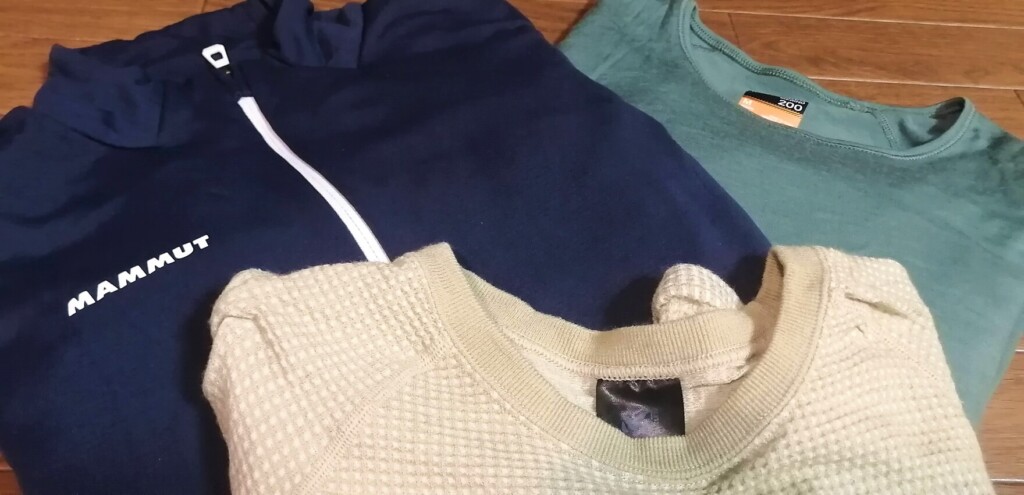
[A self-paying comparison review without any consideration] A girl who loves mountains will compare her clothes! Comparison review of wool, synthetic fiber and hybrid, winter base layer
It might be "comparing base layers now..." But I'll compare. Let me compare.
This is because I've been wearing many base layers and making mistakes, and have been using base layer gypsy. About 10 years ago, when I was a beginner in mountain climbing, I couldn't tell the difference between them all, but they all looked the same. Moreover, my skin was a bit atopic, so I couldn't imagine wool on my bare skin.
After making many mistakes, I have now settled into a constant base layer. So, based on my background and reviews of base layers, I will share a comparison of base layers for mountaineering by women, focusing mainly on the differences in materials.
table of contents
Base layer stray
Personally, there was no concept of "wool" in the base layer in the first place. Although it has become less common as an adult, when I sweat wearing a wool turtleneck, my neck is so tingly itchy that it turns bright red. I was so scared I couldn't wear wool.
So for me, synthetic fiber has always been the only choice for base layers. As a beginner, I thought that anything synthetic fiber would be fine, so I went to Nabewariyama (Kanagawa Prefecture) in winter wearing a warm inner layer from a certain fashion brand. I sweated a lot along the way, and my innerwear was drenched in sweat. I was shaking and sweating at the top of the mountain. I quickly took off my innerwear, put on a mountain shirt and ate nabeyaki udon, and escaped the trouble.
I was too ignorant. Also, after learning of the lesson, I started looking for a quick-drying base layer for mountain climbing, but for me at the time, it was so expensive that I ended up doing some casual shopping (quick-drying wear for volleyball and basketball), and found out that it wasn't suitable for mountain climbing and ended up shelving it.
Maybe wool can be used too? I thought so, I bought some clothing for mountain climbing, but it was probably because it was a thick product and it started to stake out. In the end I settled on a thick Montbell Geoline medium thickness. It took a long way to get there. After that, I came across a thin Rab base layer made of merino wool that doesn't tingle, and although it's quite fuzzy, I still use it.
Underwear
This was when I went to Kagoshima Prefecture to climb Mt. Korea and Takachiho Peak in winter. I realized that the area was colder than I had imagined, so as soon as I arrived in the city, I headed straight to an outdoor shop. I decided to buy the clothing I had missing.
This is why we recommended underwear worn underneath the base layer. It was around the time when Fine Track's dry layer was released (probably). The clerk, who was discussing about clothing, said, "I went to the mountains in France the other day wearing this, and the sweat didn't get cold at all. I climbed it on top of it using only a base layer." I didn't ask what kind of mountains and how cold it was, but they said, "It's no good to have it," so I bought it.
As predicted, the wind and snow were blowing, but it certainly didn't feel colder than before. Come to think of it, I remembered how it was shaking at Mt. Kobunobu in the snow. I wasn't wearing any underwear at the time. Ignorance is scary, and it's important to gather information. I always wear underwear after climbing in Kagoshima.
I've gone off track, but this time I'm going to post a review wearing my recent favorite Millet's so-called AmiAmi innerwear, "drynamic mesh," underneath.
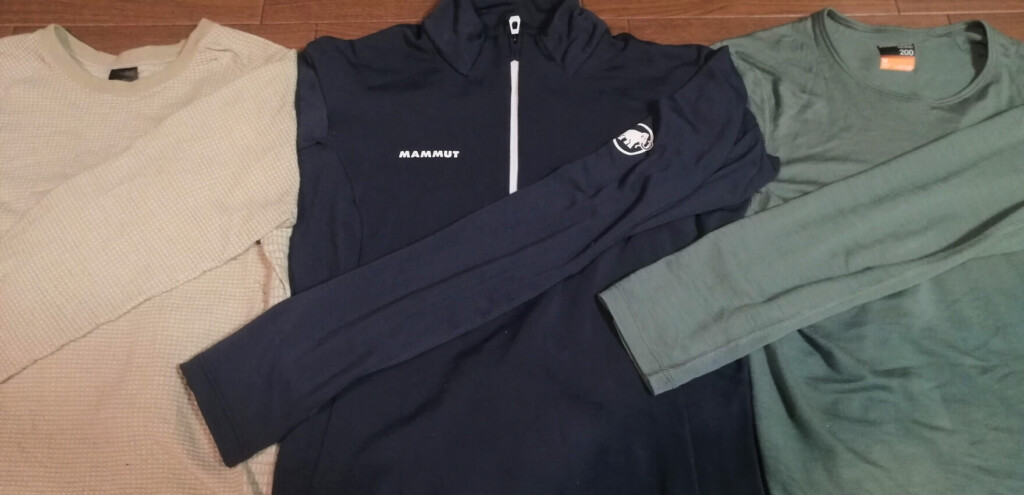
Points of evaluation
This site defines the following features required for the base layer: However, of course, there is no god model that has everything in its entirety, so when evaluating, we check the balance of each element and decide on it.
- Comfort: what is called comfortable to wear. The fabric and tailoring make it comfortable to wear while you are on the skin, fit, ease of movement, smooth seams, antibacterial and deodorizing properties, and UV protection.
- Heat retention: Not only is it warm at low temperatures, but also how can you keep your body temperature constant and dry in various situations during your activities, such as whether it relieves excessive heat when your heart rate and body temperature rise (temperature control), and even less likely to get cold from sweat when wet.
- Sweat-absorbent and quick-drying: The ability to quickly absorb sweat from the skin, drain it to the outside of clothing, and evaporate it in order to keep the skin dry at all times. If sweat continues to remain on your clothes, you are more likely to experience the discomfort of the so-called "cold sweat" that is cold when the sweat on your skin evaporates due to the cold wind.
- Deodorizing (deodorant) properties: Whether odors are less likely to occur due to sweat, etc.
By the way, the article below summarizes what purpose and scene you should choose the base layer with which features.
Related Articles
Test environment
- A certain mountain in Kanagawa Prefecture with many ups and downs and paved roads. The temperature is around 10 degrees.
- The environment is intended for late autumn to winter climbing. Please be aware that the results will be different from those in spring and summer.
- Even if you go all together with synthetic fibers or wool, there will naturally be differences in quality and processing depending on the product, so please understand that this impression does not apply to all of the same materials.
- Please note that this is also due to individual experience and subjective views.
Test results and spec comparison table
| item | [100% wool] icebreaker 200 Oasis Long Sleeve Crew | [100% synthetic fiber] MAMMUT Moenchi Advanced Half Zip Long Sleeve | [Synthetic fiber x wool blend] MILLET Whole Garment Waffle Wool Crew |
|---|---|---|---|
| This is ◎ |
|
|
|
| This is △ |
|
|
|
| Comfortable | ◎ | ◯ | ◎ |
| Thermal insulation | ◎ | ◯ | ◯ |
| Sweat-absorbent and quick-drying | △ | ◎ | ◯ |
| Deodorizing properties | ◎ | △ | ◯ |
| Specs | |||
| Fabrics and materials |
|
|
|
[Base layer impressions]
[100% wool] icebreaker 200 Oasis Long Sleeve Crew
As I mentioned at the beginning, I actually had a personal responsiveness to wool. It's itchy but expensive. I don't really like the atmosphere of wool as the only choice when it comes to mountain base layers, but I just walked straight to the path of synthetic fibers.
I thought I would continue on the highway that I hate wool, but then suddenly I met Rab's Merino wool. This is also a product recommended by outdoor store clerks. The store clerk said that in Fuyuyama, he wears almost all of that. While I was talking about how I hate itching, I was told, "Well, I should try on once," so I put it on. ...No tingling! It feels good on the skin! It fits my body somehow! It was a sale item, so I bought it as a trial purchase. I guess they didn't like it because they didn't wear it.
The reason the wool was itchy is "due to the thickness of the fibers, not because the type of fiber is wool" (from the Woolmark Company document), and it is said that it is now "effective for eczema patients" (from the same document). I don't know that "wool is itchy" is now used to treat skin diseases.
...So here's a review of merino wool. "Merino wool is the finest of wool and is derived from Merino sheep. Merino is mainly kept in Australia, New Zealand, France, and other places. The fibers are particularly fine, soft and soft to the touch. Among merino wool, the fibers are particularly fine, called extra fine merino wool and are used in high-end knitwear, suits, dresses, etc." (https://www.fashion-press.net/words/385). Merino wool is the highest quality wool, and among them, the thinner the fibers, the better the quality. My Rab is no longer available, but it feels good on the skin, not tingly or itchy, and even on sale, so it was made of high-quality merino wool material. For now, it is still alive and well without any insects.
Now, the good and not good part of merino wool material.
[Good]
- Feels good on the skin and feels good
- High moisture absorption and water absorption
- High heat retention
- Highly breathable
- Highly deodorizing
[Not good]
- Low quick drying
This is the typical feature. So, is that true? The product I wore this time was the icebreaker "200 Oasis Long Sleeve Crew."
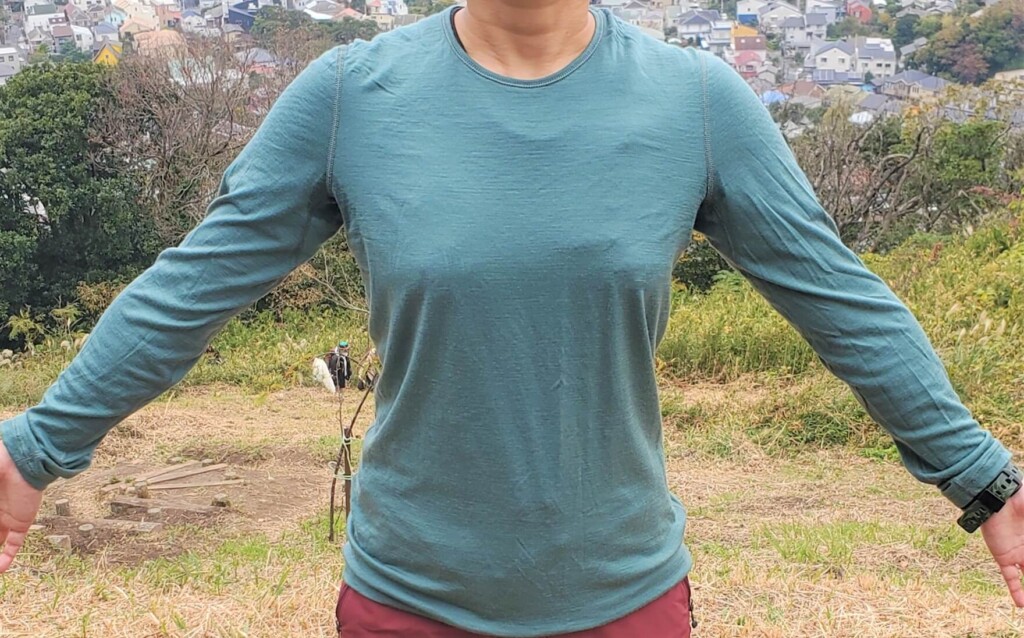
The first thing I noticed was that it felt smooth on the skin. It blends softly with the skin without causing itching.
It's so warm and warm even when worn. It gives you a sense of security as the warmth gently continues. The warmth of merino wool is irreplaceable. I'm starting to walk smoothly.
I walk silently on the paved roads, sweating slowly, but it doesn't get damp. We take a rest on a small hill that has just climbed a steep mountain path. My back and armpits are covered in quite a bit of sweat.
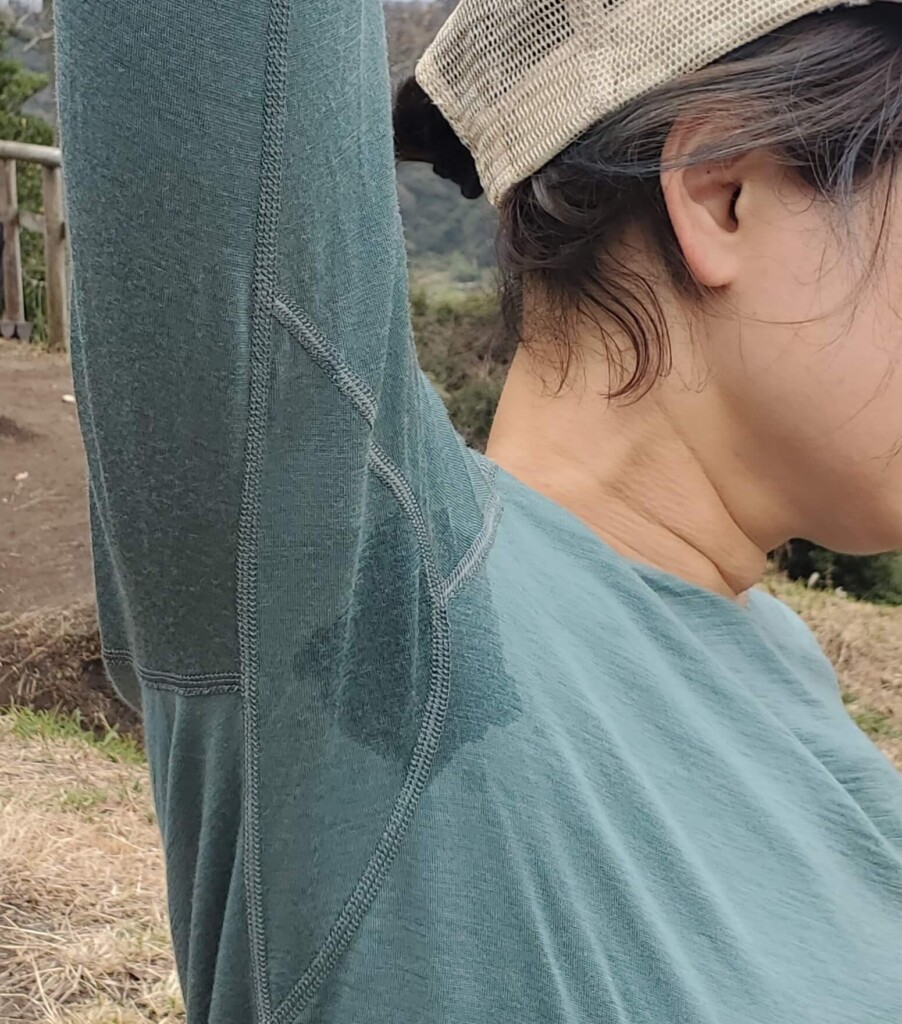
I'm sweating hard
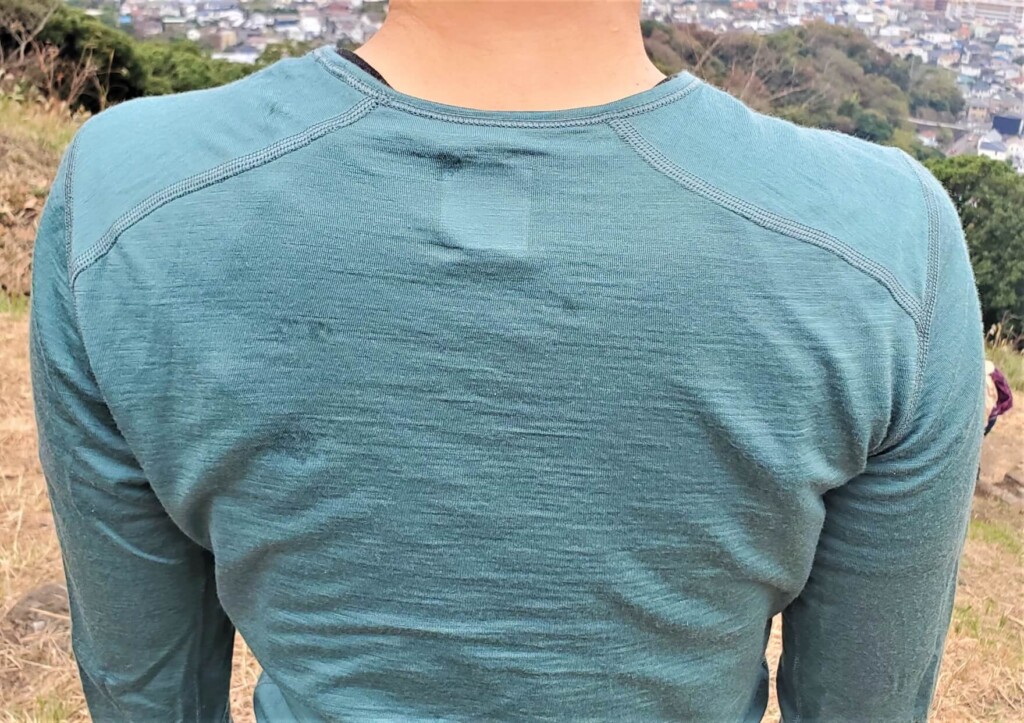
It's hard to see, but the upper back is also sweaty
The wind was blowing strong that day, and I was able to get the wind completely through my whole body. …cold. It's cold even though it's medium-thick merino wool fabric. Perhaps because it is highly breathable, a cold air flows through your body. Wait 5-10 minutes to see when it dries. It's quite frozen. After waiting for 10 minutes, I blocked the wind with a hard shell, but the coldness of my back never changed. A cold back is what brings back temperature and strength.
That's why I changed into the next base layer. Thick fabric is good for keeping you warm, but it absorbs all the heavy sweat from sweat (sweat from liquids, not gas, but from gas) and keeps moisture, so it dries clearly slower than synthetic fibers. When I started walking, I might have had a moisture absorption effect and had a heat generation effect, but once I absorbed water, I could do something about it... Merino wool may not be very suitable for winter climbing for sweaty humans.
[100% synthetic fiber] MAMMUT Moenchi Advanced Half Zip Long Sleeve
As mentioned before, my first decent base layer was Montbell's Geoline medium-thick (100% polyester). The next thing I love is the North Face, a thick, medium-thick item that's no longer available. The materials are 81% polyester, maxi fresh (a material that has deodorizing and antibacterial properties that lasts for it), and 5% polypropylene. This one is worn so it's full of fine pills. By the way, polyester is a material that is prone to pilling. Finally, I'd like to tell you about the smell after wearing clothes, but perhaps because Maxi Fresh is used, I don't really notice the smell after use. The other base layers he owns are also made from almost synthetic materials. Because you sweat, the base layer in autumn and winter is designed to protect you from getting cold and sweating, so you need to dry quickly.
The main synthetic materials used in such base layers are polyester, nylon, and polypropylene.
This is the good and not good part of synthetic fiber materials (although it is said that the functionality varies depending on the material and the processing and sewing. Synthetic fiber materials are roughly classified),
[Good part]
- Highly quick-drying (polyester is faster-drying than other synthetic fibers)
[Not good part]
- Low heat retention
- Low moisture absorption and water absorption (nylon is more moisture absorbent than other synthetic fibers)
- Almost no deodorizing properties
The specifications are almost the opposite of natural fibers. I wore the MAMMUT "Moenti Advanced Half Zip Long Sleeve."

The materials are 49% polyester, 41% nylon, and 10% polyurethane. Polyester makes it quick-drying, nylon makes it feel good on the skin and prevents stickiness, and polyurethane makes it stretchy. The comfort of the fabric is that although it is 40% mixed with nylon, it has the unique stylish texture that is typical of synthetic fibers. I'm used to it, so I don't mind it, but it doesn't match the gentle softness of merino wool.
Now start taking action. It does not contain Primaloft (a synthetic fiber with feather-like heat retention), so it is not particularly warm, but the thick fabric with tight eyes makes it difficult for wind to enter and body temperature is not easily taken away. As I continued to do small ups and downs, I started to sweat slowly. It's not summer so stickiness isn't that bothering me. After a long, steep climb, I started to get a classic sweat. The fabric has almost no water absorption properties, so sweat remains stuck to your body. It's really cold when the wind blows here.
I also start walking quite a bit. As expected of a synthetic fiber, the good thing is that no moisture will remain on the surface of the skin, and before you know it, it will no longer be tight and not be able to continue to get cold, like a "sweat cold." After all, my back doesn't get cold. This is an important point for me. As I walked along the gentle slope of the mountain path, my clothes, which were damp and sweat, dried, and the space between the fabric and the skin began to dry out.

My sweat has also dried out
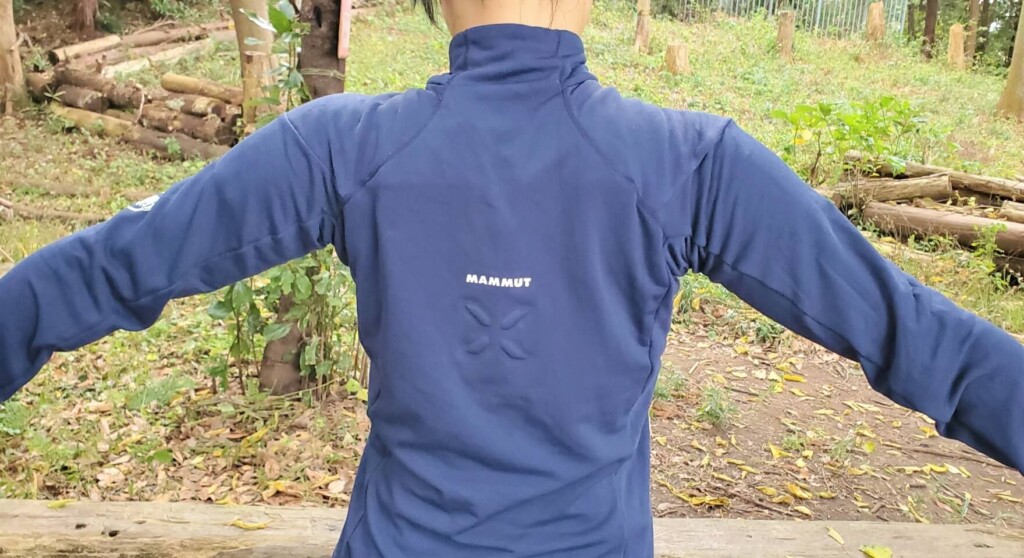
My back isn't cold either
In winter, I don't worry about the stickiness or the feeling of "slowness." I'm fine as long as I don't get too sweaty. I really like the "before I know it's dry" feel of the synthetic fiber. I don't feel any stickiness to my skin either. However, even if the air is not breathable, it will be cool if it blows in the wind. It might have been warm if it had the Primaloft mentioned above in it. Synthetic fibers generally do not have high heat retention, so if you want warmth, we recommend a product containing merino wool or a special fiber with heat retention. Synthetic fibers are perfect for those who say, "Even if you sweat a lot, as long as your clothing dries quickly, that's all you need."
[Synthetic fiber x wool blend] MILLET Whole Garment Waffle Wool Crew
The final item is MILLET's "Whole Garment Waffle Wool Crew," a new product from last fall and winter, a hybrid base layer made of wool and synthetic fiber.
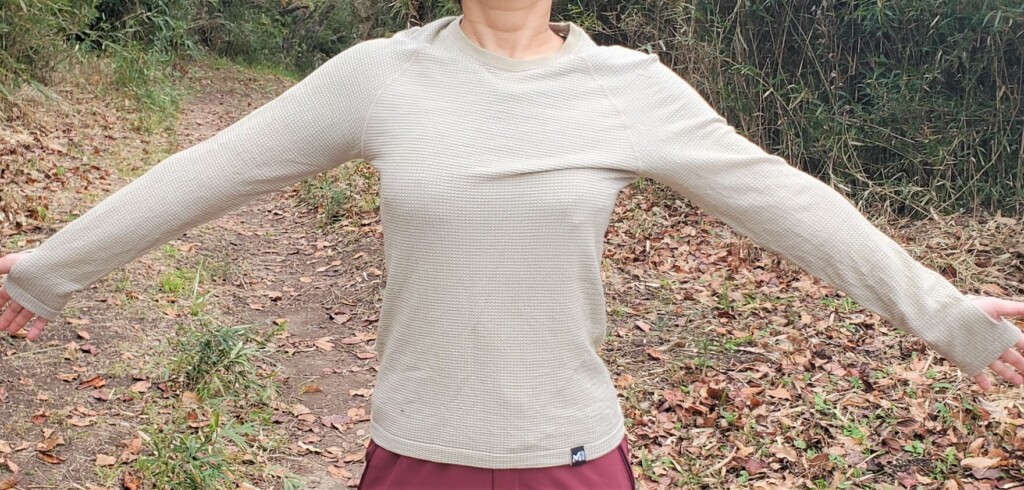
The material is 70% wool, 26% nylon, and 4% polyurethane. Wool improves heat retention and moisture absorption, nylon and polyurethane provide quick drying, and polyurethane and wool provide increased elasticity. It's my first natural and synthetic blend material, which has both the benefits of wool and synthetic fibers, and I can feel the feel of it.
The moment I put it on, it was warm. The waffle fabric blends softly with the skin. It feels like warm air is trapped between the skin and the fabric. The thickness of the fabric makes it 70% wool. The high heat retention is undeniable. It will fully demonstrate its effectiveness on roads that are not exposed to sunlight. Even if you sweat slowly, the wool is absorbent and doesn't bother you. When the wind blows, the moisturey fabric dries and the skin feels comfortable. There were times when it felt hot during the action, but the moisture-regulating properties of wool and the quick-drying properties of synthetic fibers do not overheat.
However, it was a shame that we were unable to deal with the heavy sweat after a series of sudden climbs. The fibers absorb water so much that it doesn't dry out the sweat on your back and underarms. It was a bit cold, but I could feel the cold.

It's beige so it's difficult to see, but I'm sweating my arms
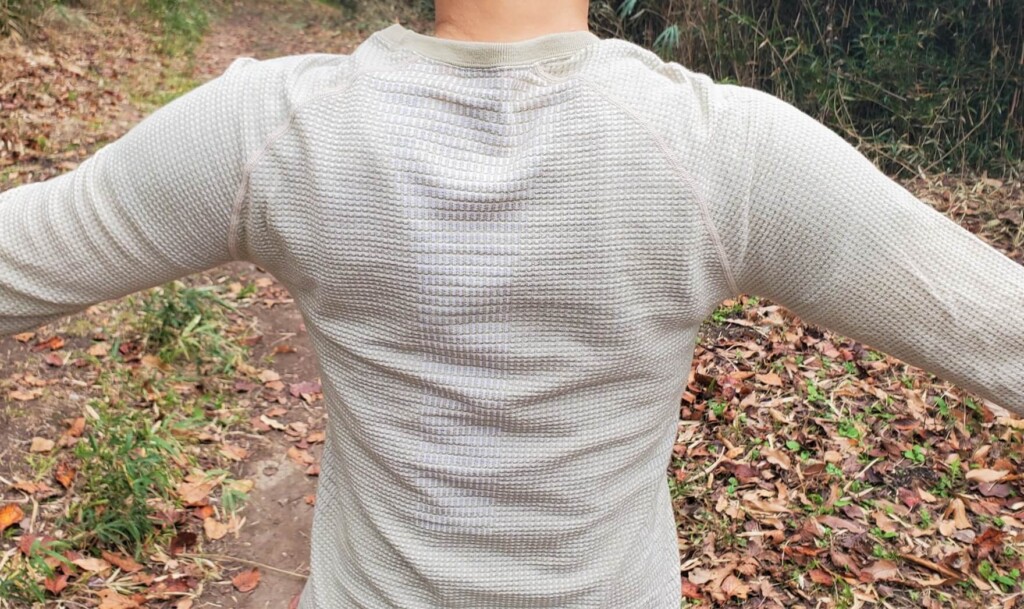
My back is also sweating well. The center is breathable knitting method.
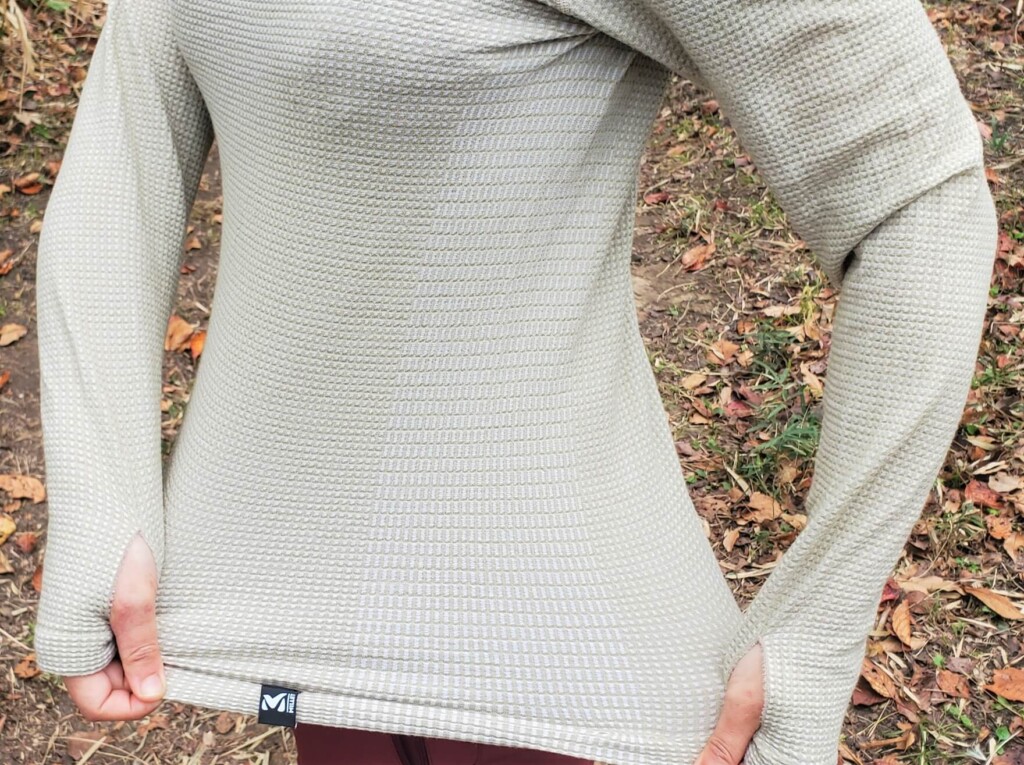
The sides are also breathable
It must have exceeded the level of quick drying. The slow drying of the merino wool has become noticeable. Just like when wearing the Icebreaker, it doesn't seem to dry even after waiting for a while. If you stay still, you'll get sweaty and get cold. I thought it would become my favorite, but it seems that it was too much of a sweat. It was perfect to wear, but I was disappointed.
Comparison of the smell of synthetic fibers and wool
The last thing left is a comparison of the smell. As you all imagined, this was a synthetic fiber that was not smelling, and a hybrid. After wearing it for a few hours a day, the synthetic fibers look stinky... The hybrids, which contain a lot of merino wool, are also "smelling..." The synthetic fibers are treated with deodorizing treatment, and merino wool has a high deodorizing effect.
I understand that those who walk or traverse long trails are more likely to choose merino wool. I don't know if anyone other than myself had any unpleasant smells, but when I wear it, I can clearly see that I am smelling. Whether or not to hold back depends on the individual's opinion, so I'll leave it to you.
summary
Here's a summary of my impressions after comparing them:
[100% wool]
For those who do not sweat a lot or heat too much, climb or traverse the mountain, slowly walking, light hiking, or who don't sweat
[100% synthetic fiber]
For those with high intensity exercises such as trail running, climbing people who walk at a fast speed, and sweating
[Wool x synthetic fiber blend]
For exercises that are not very strong, for those who walk at normal speeds around the course time, and for those who sweat moderately but not sweat. It is versatile so it can be used all-purpose.
Products have slogans that stimulate purchasing motivation, such as "completely shuts out the wind," "double drying and heat retention," and "excellent deodorizing effect," but when you actually use it, you may end up thinking, "Huh?", for better or worse. Yes, you won't know until you try it. So I wanted to share the process that has led to the present day by accumulating trial and error.
The base layer closest to the skin is an important clothing that can also affect your life. In winter, you tend to be concerned about outerwear such as down, fleece, and hard shells, but it might be a good idea to take this opportunity to rethink your base layer.


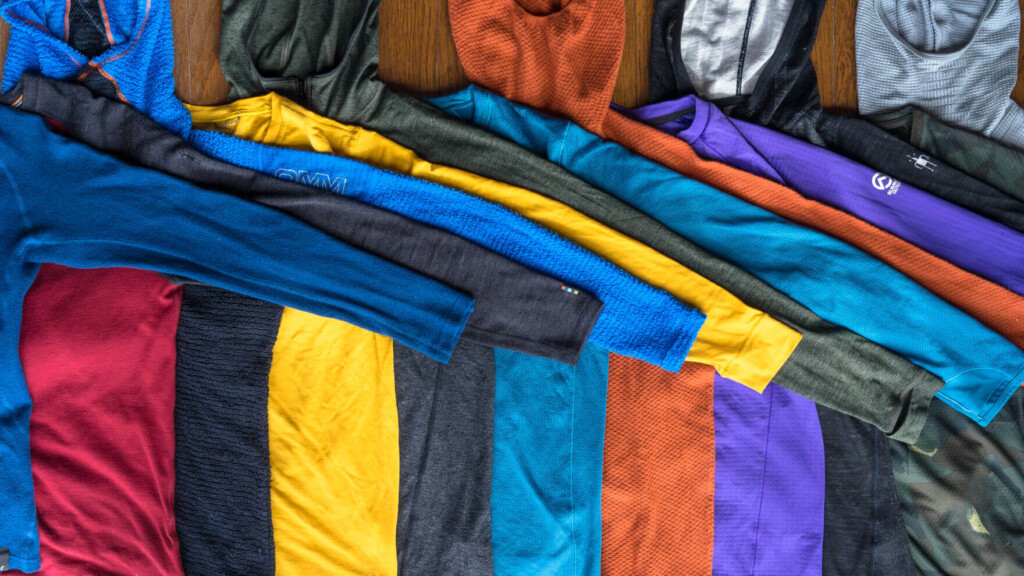 [A self-paying review without consideration] A selection of 40 or more base layers, and by actual comparison of the best buys by scene and purpose.
[A self-paying review without consideration] A selection of 40 or more base layers, and by actual comparison of the best buys by scene and purpose. [Fall/Winter 2025] A hidden necessity for snow sports: the best balaclava models for different uses and preferences, plus tips on how to choose one without regrets
[Fall/Winter 2025] A hidden necessity for snow sports: the best balaclava models for different uses and preferences, plus tips on how to choose one without regrets Review: icebreaker Merino Wool Base Layer Zone Series The latest Merino Wool is not just about "warm!"
Review: icebreaker Merino Wool Base Layer Zone Series The latest Merino Wool is not just about "warm!" [Fall/Winter 2025] Recommended base layers for this season and purpose, selected after comparing over 200 items, and how to choose the perfect one for you
[Fall/Winter 2025] Recommended base layers for this season and purpose, selected after comparing over 200 items, and how to choose the perfect one for you